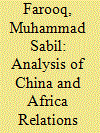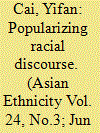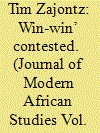|
|
|
Sort Order |
|
|
|
Items / Page
|
|
|
|
|
|
|
| Srl | Item |
| 1 |
ID:
169366


|
|
|
|
|
| Summary/Abstract |
China’s ‘One Belt One Road’ (OBOR) initiative has been billed as its most ambitious project ever in trying to shape and influence behaviour in the international system in line with her growing stature. At the same time, growing Sino-Africa relations have been the subject of scholarly debate with supporters taking an optimistic view, also presented by China itself, of this relationship being a win-win partnership. Critics led by the United States argue China is just using Africa to extract resources for its use, an allegation it refutes. The authors therefore sought to look at Sino-African relations but focussing on the implementation of OBOR in the African continent. Being the centrepiece of China’s foreign policy since 2013, a study on OBOR in Africa will give an understanding and hopefully answer some questions surrounding these relations. The lack of official bilateral agreements between China and some African countries has been examined, together with the possibility of expansion of the OBOR initiative to cover more African states.
|
|
|
|
|
|
|
|
|
|
|
|
|
|
|
|
| 2 |
ID:
170746


|
|
|
|
|
| Summary/Abstract |
In 2012, a Chinese developer, Zendai, purchased 1,600 hectares of land in Modderfontein, Johannesburg, and announced plans for a new urban megadevelopment. Hiring a Chinese designer, the company released a series of computer-generated images. Drawing on these, the media and many in the city perceived the site to be distinctly “Chinese,” rooted in futuristic, speculative visions of urbanity. At the same time, African urban research turned its attention to similar large-scale projects throughout the continent, and has continued to speculate on their consequences. Building on these two different interpretations of Modderfontein, this paper engages with the site as a manifestation of both global trends (e.g., increasing Chinese engagement with Africa, urban inter-referencing throughout the Global South) and a reflection of place- and context-specific factors. In doing so, we focus on the ordinariness of the project to interrogate how the idea of creating an ultramodern global economic hub, rooted in the experiences and practices of a Chinese-based developer, was in the end mediated by the actions of international consultants and the City of Johannesburg. We suggest that Modderfontein should be seen as a generative form of urbanism where elements perceived to be Chinese were lost in the master planning process. We argue that the socio-material dimensions of the project instead reflect a distinctly South African urbanism.
|
|
|
|
|
|
|
|
|
|
|
|
|
|
|
|
| 3 |
ID:
190309


|
|
|
|
|
| Summary/Abstract |
The rise of social media has enabled Chinese migrants in the global south to participate in the production of racial knowledge from grassroots perspectives, adding complexity and dynamism to the racial discourse that was dominated by political and intellectual elites historically. This study investigates anti-black racial discourse on the popular short-video and live-streaming app in China, Kuaishou, where many Africa-based vloggers share their daily life experiences. This study examines the visual and verbal representation of Africans, focusing on 50 short videos posted by Africa-based Chinese and the comments made on them. The analysis shows that the racialization of Africans on Kuaishou is a multilayered process shaped by the intersection of race with other dimensions of identity, including class, gender, and nationality. This paper further illuminates the cultural embeddedness of these thoughts in a South-South setting, and discusses the impacts of different historical-ideological resources on racial thinking in the Chinese context.
|
|
|
|
|
|
|
|
|
|
|
|
|
|
|
|
| 4 |
ID:
183924


|
|
|
|
|
| Summary/Abstract |
As infrastructure development has become a key ingredient in Africa–China relations, the role of African governments in co-determining the design, funding and governance of the continent's infrastructures has come under close scrutiny. This article sheds light on the rehabilitation of a symbol of Sino–African friendship: the Tanzania–Zambia Railway Authority (TAZARA). Employing Jessop's strategic-relational approach, it is shown that the strategies of the shareholding governments in the negotiations with a Chinese consortium were informed by strategic learning from previous railway privatisations, corresponding cost–benefit analyses and reflection about Chinese commercial interests. Zambia's indebtedness and Tanzania's autocratic developmental state under President Magufuli formed crucial elements of the structural context in which the fate of Africa's Freedom Railway was negotiated. The article transcends both crudely structuralist accounts of a supposedly all-powerful China and voluntarist conceptions of African agency that are void of structure. Assessing (African) agency requires analytical sensitivity towards the dialectical interaction between specific strategic capacities and strategically selective political–economic contexts.
|
|
|
|
|
|
|
|
|
|
|
|
|
|
|
|
|
|
|
|
|